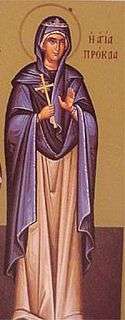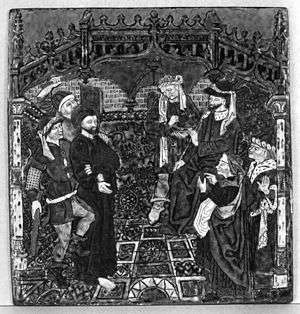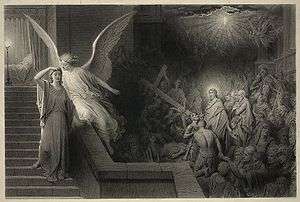Pontius Pilate's wife
| Saint Procla | |
|---|---|
 Greek icon of Saint Procla (Hagia Prokla) | |
| Governess of Judea Saint, Widow and Martyr | |
| Venerated in |
Eastern Orthodox Church Ethiopian Orthodox Church |
| Feast |
27 October (Eastern Orthodox) 25 June (Ethiopian Orthodox) |
Pontius Pilate's wife, otherwise unnamed in the Bible, appears in a single verse of the Gospel of Matthew, where she tries to persuade her husband not to condemn Jesus to death.
She is named as Procla or Procula in early Christian tradition (later also Percula, Claudia Procula or Claudia Procles). She is considered a saint in the Eastern Orthodox Church and the Ethiopian Orthodox Church.
Christian tradition
In the New Testament, the only reference to Pontius Pilate's wife exists in a single sentence by Matthew:
When he was set down on the judgment seat, his wife sent unto him, saying, Have thou nothing to do with that just man: for I have suffered many things this day in a dream because of him."
The Gospel narrative continues that Pilate was being pressured to sentence Christ to death, but "washed his hands", asserting that "I am innocent of this man's blood" (see Blood curse, Jewish deicide).
In the 3rd century, Origen suggested in his Homilies on Matthew that the wife of Pilate had become a Christian,[1][2] or at least that God sent her the dream mentioned by Matthew so that she would convert.[3][4] This interpretation was shared by several theologians of Antiquity and the Middle Ages. The apocryphal Letter of Pilate to Herod, dating from around the 3rd–4th century, names Pilate's wife as Procla and connects to the story of Matthew 27:19.[5] Pilate and his wife are here portrayed as Christian converts.[6] The apocryphal Gospel of Nicodemus, also known as Acta Pilati, probably written around the middle of the 4th century, gives a more elaborate version of the episode of the dream than Matthew, and names Pilate's wife as Procula.[7][8][9][3]
Procula is recognized as a saint in two churches within the Eastern Christian tradition: the Eastern Orthodox Church and the Ethiopian Orthodox Church. In the Eastern Orthodox Church, she is celebrated on 27 October. The Ethiopian Orthodox Church celebrates Pilate and Procula together on 25 June.[1][10]
By contrast, later Western tradition contended the dream was sent by the Devil in an attempt to thwart the salvation that was going to result from Christ's death.[3][4] A 12th-century Latin Passion play[11] describes the dream of Pilate's wife as an apparition of the devil (diabolus appareat ei).[12]

Pilate's wife is sometimes shown in medieval depictions of scenes including her husband. She typically stands behind him, sometimes whispering in his ear, while other representations of Matthew's version of the scene in Pilate's court may depict an intermediary delivering the message of Pilate's wife to her husband.[13]
Pilate's wife is a major character in the 30th York Mystery Play (Tapiters' and Couchers' Play), where she introduces herself as "Dame Precious Percula".[14] Her dream is dictated by the Devil. He first soliloquises to the effect that if Jesus dies, he, the Devil, will lose control of men's souls. He then tells the sleeping Percula that Jesus is innocent, and that if he is condemned, she and Pilate will lose their privileged position. She wakes and sends a message to Pilate, but Annas and Caiaphas succeed in convincing him that her dream was inspired by Jesus' witchcraft.
Modern reception
Early modern


Aemilia Lanyer's volume of poems Salve Deus Rex Judaeorum (1611) contains a poem of the same title, in which Pilate's wife is the main speaker. She makes reference to the Fall of Adam and Eve, and argues that Pilate's sin in killing Christ abrogates the curse on Eve, since Pilate sinned by not listening to his wife (unlike Adam, who sinned by hearkening to the voice of Eve).
Pseudo-Dexter combined pre-existing traditions that alternatively called Pilate's wife Procula and Claudia into the single name Claudia Procula.[15]
19th century
In Anne Catherine Emmerich's visions, as recounted by Clemens Brentano, she appears as Claudia Procles.[16] "Pilate's Wife's Dream" is an 1846 poem by Charlotte Brontë.[17]
A letter, purportedly written by Pilate's wife, was first published, in Slovenian, in the Catholic journal Kmetijske in rokodelske novice in 1865. According to the publication, the letter was translated from French by Luiza Pesjak.[18] An English translation of the purported letter was published as Letter from Pontius Pilate's Wife.[19]
20th and 21st centuries
Pilate's wife was called Proculla in the Cecil B. DeMille epic The King of Kings (1927) in which Majel Coleman played the role. She had a major part in Julien Duvivier's Golgotha (1935), played by Edwige Feuillère.
Pilate's Wife, published posthumously in 2000, is a novel H.D. (Hilda Doolittle) wrote between 1929 and 1934, in which Pilate's wife has the name Veronica.[20]
"The Wife of Pilate" is a 1955 novella by Gertrud von Le Fort.[21]
The Bride of Pilate is a 1959 novel by Esther Kellner.
On television, Pilate's wife was played by Joan Leslie in the 1951 Family Theater episode "Hill Number One" (also starring James Dean as John the Apostle), and by Geraldine Fitzgerald in the 1952 Studio One episode "Pontius Pilate" (where Procula is depicted as half-Jewish, and is brought before Pilate as a Christian rebel herself, fifteen years after Jesus' death).
Pilate's wife is mentioned briefly in Pilate's hand-washing scene in The Robe (1953) ("Even my wife had an opinion"). Other cinematic appearances for the character include the film Day of Triumph (1954, played by Barbara Billingsley), the film King of Kings (1961, played by Viveca Lindfors—in which the character is identified as the daughter of the Emperor Tiberius), the Italian film Ponzio Pilato (1962, played by Jeanne Crain) and the epic The Greatest Story Ever Told (1965, played by Angela Lansbury). Also, Marjorie Lord performed the role of Claudia Procula on stage in 1963.[22]
John Case played her in Monty Python's Life of Brian (1979).[23] Hope Lange played Pontius Pilate's wife in the 1980 made-for-television film The Day Christ Died.
The character is also depicted in the film The Inquiry (1986) in which she is played by Phyllis Logan, as well as in that film's 2006 remake, played by Anna Kanakis.[24]
In the film The Passion of the Christ (2004), she is known as Claudia Procles (and played by Claudia Gerini). In this film, Claudia fails in her effort to lobby her husband to save Jesus,[25] and consoles Jesus' mother Mary and Mary Magdalene as she hands them towels to clean up the blood from his scourging.[26]
Pilate's wife is featured in the 2008 TV serial The Passion, played by Esther Hall, and in the 2013 miniseries The Bible, portrayed by Louise Delamere.[27] Delamere reprised her role in 2014's Son of God.
Joanne Whalley portrayed Pilate's wife in the 2015 series A.D. The Bible Continues.[28]
Carol Ann Duffy's 1999 poetry collection The World's Wife contains a poem titled "Pilate's Wife".
Two novels by Antoinette May, Pilate's Wife: A Novel of the Roman Empire (2006)[29] and Claudia: Daughter of Rome (2008), use the name Claudia, as does Diana Wallis Taylor in a novel, Claudia: Wife of Pontius Pilate (2013). Both May and Wallis depict her parents as Roman aristocrats related by blood to Emperor Augustus.
D.S. Ryelle's Early One Morning has several brief appearances by Claudia Procula—in one scene, she appeals to the high priestess of Isis when she has a nightmare involving her husband.[30]
In his historical novel The Advocate, Randy Singer refers to Pilate's wife as "Procula" and tells of an earlier vision in which she had seen and been healed by Jesus.[31]
References
- 1 2

- ↑ Paul L. Maier. Pontius Pilate: A Biographical Novel. Kregel Publications, 1995, ISBN 0-8254-3296-0, p. 370 (endnotes to Chapter 26)
- 1 2 3 Sticca 1970, p. 98
- 1 2 Ulrich Luz, Helmut Koester (contributor), James E. Crouch (translator). Matthew 21-28: A Commentary. Fortress Press, Minneapolis, 2005, ISBN 0-8006-3770-4, p. 499
- ↑ Ehrman and Pleše 2011, p. 519
- ↑ Ehrman and Pleše 2011, p. 517.
- ↑

- ↑ The Acts of Pilate, Chapter 2, Paragraph 1, translated by M. R. James
- ↑ "The Gospel of Nicodemus, or Acts of Pilate", from The Apocryphal New Testament, M.R. James (translation and notes). Oxford: Clarendon Press, 1924
- ↑ "The Fate of Pontius Pilate," Hermes 99.3 (1971), p. 362.
- ↑ Sticca 1970, p. 51
- ↑ Sticca 1970, p. 72
- ↑ G Schiller, Iconography of Christian Art, Vol. II,1972 (English trans from German), Lund Humphries, London, p. 66, and passim see Index, ISBN 0-85331-324-5
- ↑ original text of Tapiters and Couchers Play at University of Michigan
- ↑ Katrina B. Olds. Forging The Past: Invented Histories in Counter-Reformation Spain. Yale University Press, 2015. ISBN 978-0-300-18522-5), p. 119. Erwin Preuschen, Zeitschrift für die Neutestamentliche Wissenschaft und die Kunde der älteren Kirche, Volumes 86-87 (Berlin: W. de Gruyter, 1995). Paul Maier, Pontius Pilate: A Biographical Novel (1968), argues that the name "Claudia" is from "a later tradition"
- ↑ Clemens Brentano, after an oral account by Anne Catherine Emmerich. The Dolorous Passion of Our Lord Jesus Christ. 1833. (At Project Gutenberg: 20th edition, 1904)
- ↑ "Pilate's Wife's Dream" by Charlotte Brontë
- ↑ Kmetijske in rokodelske novice, 12.04.1865, volume 23, number 15, pages 117-120
- ↑ Catherine Van Dyke. Letter from Pontius Pilate's Wife. TEACH Services, Incorporated, 2008. ISBN 1572585765
- ↑ Amazon.ca/Library Journal review
- ↑ Francis Phillips. "A Christian genius and her inspired account of the life of Pilate’s wife" in The Catholic Herald, 1 April 2015
- ↑ Time Magazine, 1963-04-12: "Gospel According to Claudia"
- ↑ Chapman, Graham; Cleese, John; Gilliam, Terry; Idle, Eric; Jones, Terry; Palin, Michael (1979). Monty Python's The Life of Brian/Montypythonscrapbook. London: Eyre Methuen.
- ↑ Halliwell, Leslie (2003). Halliwell’s Film & Video Guide. HarperResource. ISBN 0-06-050890-6.
- ↑ Variety review
- ↑ Boston Globe
- ↑ Film and TV productions featuring the character Claudia Procula
- ↑ Joanne Whalley plays "Claudia" in :AD: The Bible Continues"
- ↑ USA Today coverage of "Pilate's Wife"
- ↑ D.S. Ryelle. Early One Morning. DarkMoon Publishing. (October 27, 2013), ASIN B00G8GJ0R4.
- ↑ Randy Singer. The Advocate. Tyndale House Publishers, Inc. (May 1, 2014), ISBN 978-1414391304.
Cited works
- Ehrman, Bart; Pleše, Zlatko (2011). The Apocryphal Gospels: Texts and Translations. Oxford University Press, USA. ISBN 978-0-19-973210-4.
- Sticca, Sandro (1970). The Latin Passion Play: Its Origins and Development. SUNY Press. ISBN 0873950453
External links
![]()